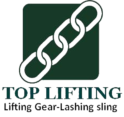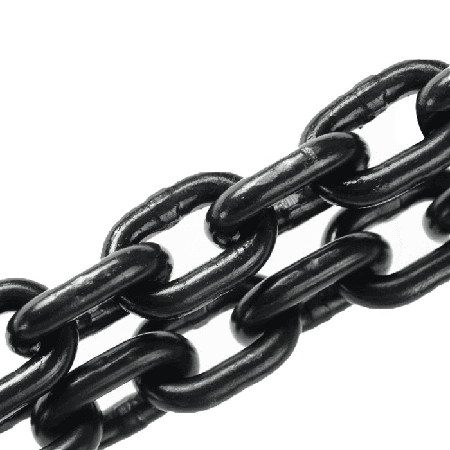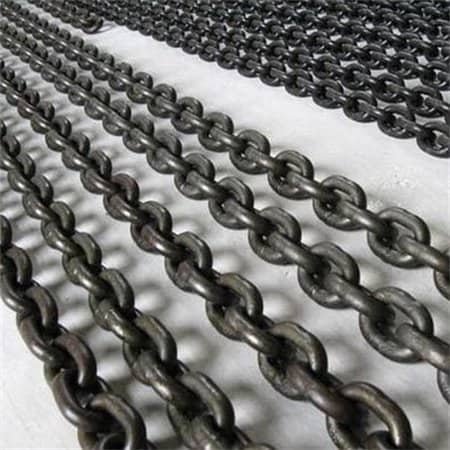🏗️ WLL OF LIFTING CHAIN SLING
When it comes to heavy-duty lifting in construction, steel fabrication, ports, and offshore applications, lifting chain slings are a top choice for their strength, durability, and resistance to harsh environments. But selecting the right chain sling isn’t just about choosing the thickest chain — it’s about knowing exactly how much weight your sling can safely handle.
🔍 What Is Working Load Limit (WLL) and Why It Matters
The Working Load Limit (WLL) is the maximum weight a lifting chain sling can safely lift under normal working conditions. It’s the cornerstone of safe lifting operations and is determined by:
- The chain diameter
- The grade of steel (e.g., G80, G100)
- The configuration of the sling (single, double, triple, or quadruple legs)
- The lifting angle
- The WLL of each individual component (hooks, master links, connectors)
✅ Important: A lifting sling is only as strong as its weakest part. If the hook’s WLL is lower than the chain’s WLL, then the hook dictates the maximum load capacity.
G80 Chain Sling WLL Chart (Single to 4-Leg)

The following chart gives you a reference for G80 chain slings in various configurations.
EN818-4
| Factor of safety | Singl-leg chains | 2 legs chains | 3 and 4 legs chains | Endless chain | Basket chains | ||||||
| 4 | |||||||||||
| Working angles | – | – | 0°-45° | 45°-60° | 0°-45° | 45°-60° | 0°-45° | 45°-60° | – | 0°-45° | 0°-45° |
| Load factor | 1 | 0.8 | 1.4 | 1 | 1.12 | 0.8 | 2.1 | 1.5 | 1.6 | 1.4 | 2.1 |
| Dia | Working Load Limits(Tonne) | ||||||||||
| 6 | 1.12 | 0.9 | 1.6 | 1.12 | 1.25 | 0.9 | 2.36 | 1.7 | 1.8 | 1.6 | 2.36 |
| 7 | 1.5 | 1.2 | 2.12 | 1.5 | 1.68 | 1.2 | 3.15 | 2.24 | 2.5 | 2.12 | 3.15 |
| 8 | 2 | 1.6 | 2.8 | 2 | 2.24 | 1.6 | 4.25 | 3 | 3.15 | 2.8 | 4.25 |
| 10 | 3.15 | 2.5 | 4.25 | 3.15 | 3.55 | 2.5 | 6.7 | 4.75 | 5 | 4.25 | 6.7 |
| 13 | 5.3 | 4.25 | 7.5 | 5.3 | 5.9 | 4.25 | 11.2 | 8 | 8.5 | 7.5 | 11.2 |
| 16 | 8 | 6.3 | 11.2 | 8 | 9 | 6.3 | 17 | 11.8 | 12.5 | 11.2 | 17 |
| 20 | 12.5 | 10 | 17 | 12.5 | 14 | 10 | 26.5 | 19 | 20 | 17 | 26.5 |
| 22 | 15 | 12 | 21.2 | 15 | 16.8 | 12 | 31.5 | 22.4 | 24 | 21.2 | 31.5 |
| 26 | 21.2 | 16.95 | 30 | 21.2 | 23.7 | 16.95 | 45 | 31.5 | 33.5 | 30 | 45 |
| 32 | 31.5 | 25.2 | 45 | 31.5 | 35.2 | 25.2 | 67 | 47.5 | 50 | 45 | 67 |
⚠️ Note: As the angle increases, the WLL decreases significantly due to the horizontal force applied.
How Leg Configuration Affects WLL
The number of legs in your chain sling increases the load capacity—but only when used correctly and within recommended angle ranges.
1️⃣ Single Leg
- Simplest configuration
- Vertical lifting only
- Full WLL applies (see table above)
2️⃣ Two Legs (0°–45° Angle)
- Multiplies WLL by approx. 1.4
- Ideal for balanced loads
- Legs must be equally loaded
3️⃣/4️⃣ Three or Four Legs
- Multiplies WLL by approx. 2.1
- Common for lifting large or irregular objects
- Note: only 3 legs actually bear the load, the fourth offers balance or backup
The Impact of Lifting Angle on WLL
The angle between the legs has a direct impact on the effective WLL.
| Angle Between Legs | Safety Factor (Multiplier) |
|---|---|
| 0°–45° | Full WLL (1.4x / 2.1x) |
| 45°–60° | Reduced WLL (~0.8x) |
| > 60° | Not recommended |
Why? As the angle increases, more side force is introduced, which stresses the chain and hook more than a vertical lift would.
Best practice: Keep sling legs at no more than 45° from vertical.
🪝 What About the Hooks and Connectors?
Many accidents occur not because the chain fails—but because the accessories aren’t rated for the same load.
Each part must have a matching WLL, including:
- Master link
- Hooks (clevis, eye, or grab hooks)
- Shortening clutches or connectors
Pro Tip: Always check the WLL marking on each component. If one part lacks it — don’t use it.
Safety Tips for Chain Sling Use
To make sure your lifting operation stays within safe limits:
- ✅ Use a printed or digital WLL chart on-site for quick checks
- ✅ Inspect the sling before each use for wear, corrosion, or deformation
- ✅ Make sure hooks and components are rated for equal or higher WLL
- ✅ Control the sling angle using spreader bars or rigging gear
Need Help Choosing the Right Chain Sling?
We manufacture and export a wide range of G80 & G100 chain slings, available in 1–4 leg configurations, with full certification and customization options.


